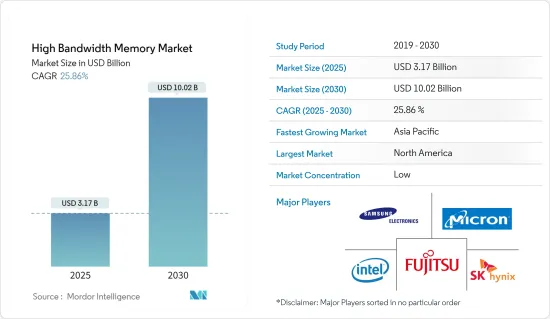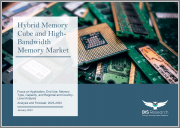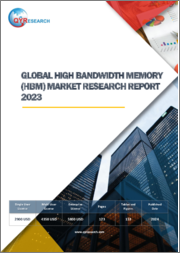
|
시장보고서
상품코드
1689968
고대역폭 메모리(HBM) : 시장 점유율 분석, 산업 동향 및 통계, 성장 예측(2025-2030년)High Bandwidth Memory - Market Share Analysis, Industry Trends & Statistics, Growth Forecasts (2025 - 2030) |
||||||
고대역폭 메모리(HBM) 시장 규모는 2025년 31억 7,000만 달러에 이르고 2030년에는 100억 2,000만 달러에 달하며, 예측 기간(2025-2030년)의 CAGR은 25.86%를 나타낼 것으로 전망됩니다.

고대역폭 메모리(HBM)는 3D 스택 SDRAM용 고속 컴퓨터 메모리 인터페이스이며, 일반적으로 고성능 그래픽 가속기, 네트워크 장치 및 슈퍼컴퓨터에서 사용됩니다.
고대역폭 메모리(HBM) 시장의 성장을 견인하는 주요 요인으로는 고대역폭, 저소비 전력, 고확장성 메모리에 대한 요구 증가, 인공지능 채용 증가, 전자기기의 소형화 동향 증가 등이 있습니다.
회로에 8개의 DRAM 다이를 적층하고 TSV로 상호 연결함으로써 HBM은 비교적 작은 폼 팩터로 적은 전력 소모로 상당히 높은 대역폭을 제공합니다. 또한 128비트 채널과 총 8채널로 HBM은 1,024비트 인터페이스를 설명합니다. 4개의 HBM 스택이 있는 GPU는 4,096비트 메모리 버스를 제공합니다.
예를 들어, 2024년 6월 미국의 메모리 칩 제조업체인 Micron Technology는 미국 내에서 고급 고대역폭 메모리(HBM) 칩 테스트 생산 라인을 건설했습니다. 이 회사는 AI 붐에 대한 수요를 더욱 캡처하기 위해 말레이시아에서 처음으로 HBM을 제조하는 것을 고려하고 있습니다.
그래픽 용도가 증가함에 따라 고속 정보 전달(대역폭)에 대한 욕구도 높아지고 있습니다. 따라서 HBM은 성능과 전력 효율 측면에서 이전에 사용되었던 GDDR5보다 우수하며 고대역폭 메모리(HBM) 시장의 성장 기회를 제공합니다.
게다가 대형 반도체 벤더는 COVID-19의 대유행에 의해 생산 능력을 저하시키면서 작업을 실시했습니다. 또한 노동자 부족으로 인해 중국의 많은 포장 공장과 테스트 공장이 운영을 축소하거나 중단했습니다. 이 때문에 이러한 백엔드의 포장이나 테스트 능력에 의존하는 칩 기업에게는 병목이 되었습니다.
그러나 시장 성장을 뒷받침하는 요인으로는 인공지능 채용 증가, 저소비 전력, 고대역폭 폭, 확장성이 높은 메모리에 대한 수요 증가, 전자기기의 소형화 경향 증가 등이 있습니다.
고대역폭 메모리(HBM) 시장 동향
자동차 및 기타 용도 부문이 크게 성장할 전망
- 고대역폭 메모리(HBM)의 용도는 자율주행차와 ADAS 통합의 대두에 의해 자동차 산업에 퍼지고 있습니다. 자동차 산업의 진보는 고성능 메모리의 채택을 촉진하고 고대역폭 메모리(HBM) 시장의 성장을 지원합니다.
- HBM은 2.5D 기술을 사용하여 기존 DRAM을 개선함으로써 진화하고 CPU에 접근하는 동시에 신호 구동에 필요한 전력을 줄이고 RC 대기 시간을 최소화합니다. 자율 주행 시장은 확대되고 있으며 환경 해석과 분석을 위해 데이터 세트를 광범위하게 사용하고 있습니다. 오작동이나 임박한 참사를 방지하기 위해 데이터 처리는 매우 빠른 속도로 수행됩니다. 빠르고 강력한 GPU 수요는 시스템에 탑재되는 고대역폭 메모리(HBM) 수요를 높입니다.
- 2024년 3월, 메모리 칩 제조업체인 Samsung Electronics는 6세대 AI 메모리 HBM4와 AI 가속기 Mach-1의 개발과 함께 생산 수율을 높이기 위해 메모리 칩 부문 내에 고대역폭 메모리(HBM) 팀을 설치했습니다. 신팀은 DRAM과 NAND 플래시 메모리의 개발·판매를 담당합니다.
- 선진 운전 지원 기술은 자율 주행과 함께 자동차 산업에서 상당히 보급되고 있습니다. 이전 ADAS 설계에서는 DDR4 및 LPDDR4와 같은 메모리 칩이 사용되었습니다. 그러나 자동차 산업이 비용 효과에서 더 나은 성능 매개변수로 이동함에 따라 ADAS 제조업체는 HBM 기술을 설계 아키텍처에 통합했습니다.
- 자동차 기술의 급속한 진보와 자동차 에지 기술 이용 증가는 조사 대상 시장에서 고대역폭 메모리(HBM)와 DDRAM 매출을 끌어올릴 것으로 예상됩니다.
북미가 시장에서 가장 큰 점유율을 차지
- 북미에서 HBM의 높은 채용률은 주로 고속 데이터 처리에 고대역폭 메모리(HBM) 솔루션을 필요로 하는 고성능 컴퓨팅(HPC) 용도의 성장 때문입니다. 북미의 HPC 수요는 AI, 머신러닝, 클라우드 컴퓨팅 수요 증가로 확대되고 있습니다.
- 급변하는 기술과 산업 전반에 걸쳐 많은 양의 데이터를 생성함으로써 효율적인 처리 시스템이 필요합니다. 이들도 이 지역의 고대역폭 메모리(HBM) 시장 수요를 촉진하는 요인의 하나가 되고 있습니다.
- 또한 미국 정부는 데이터센터 최적화 이니셔티브(Data Center Optimization Initiative : DCOI)를 시작하고 국내의 많은 데이터센터를 통합하여 납세자에 대한 투자 대 효과를 높이면서 국민에게 더 나은 서비스를 제공하는 것을 목표로 하고 있습니다.
- 북미의 메모리 제조 기업은 제품 확대의 기회를 살펴보고 있습니다. Rapids가 지원하는 DDR5는 서버용 메모리의 현재의 동향인 DDR4를 대신해 고대역폭 메모리(HBM)를 지원하는 전망으로, CPU가 이용할 수 있는 메모리 대역폭을 대폭 확대할 가능성이 있습니다.
고대역폭 메모리(HBM) 산업 개요
고대역폭 메모리(HBM) 시장은 매우 세분화되어 있습니다. Corporation, Fujitsu 주식회사 등이 있습니다.
- 2024년 4월-TSMC는 SK Hynix와 차세대 HBM(고대역폭 메모리)과 차세대 포장 기술 개발에 관한 각서를 체결했습니다.
- 2024년 3월-Camtek Ltd.는 고대역폭 메모리(HBM)의 검사·계측에 대해, 일류 HBM 제조업체로부터 약 2,500만 달러의 신규 수주를 획득했다고 발표했습니다.
기타 혜택
- 엑셀 형식 시장 예측(ME) 시트
- 3개월간의 애널리스트 서포트
목차
제1장 서론
- 조사의 전제조건과 시장 정의
- 조사 범위
제2장 조사 방법
제3장 주요 요약
제4장 시장 인사이트
- 시장 개요
- 산업 밸류체인 분석
- 산업의 매력 - Porter's Five Forces 분석
- 공급기업의 협상력
- 구매자/소비자의 협상력
- 신규 참가업체의 위협
- 대체품의 위협
- 경쟁 기업간 경쟁 관계의 강도
- 시장에 대한 COVID-19의 영향 평가
- 시장 성장 촉진요인
- 고대역폭, 저소비 전력, 고확장성 메모리에의 요구 증가
- 인공지능의 채용 증가
- 전자기기의 소형화 동향의 고조
- 시장의 과제
- HBM과 관련된 엄청난 비용과 설계의 복잡성
- DRAM 시장
- DRAM 수익과 수요 예측(2023-2028년)
- 지역별 DRAM 수익(HBM 시장과 같은 지역)
- DDR5 RAM 제품의 현재 가격
- DDR5 제품 제조업체 일람
제5장 시장 세분화
- 용도별
- 서버
- 네트워킹
- 소비자
- 자동차 및 기타 용도
- 지역별
- 북미
- 미국
- 캐나다
- 유럽
- 독일
- 프랑스
- 영국
- 기타 유럽
- 아시아태평양
- 인도
- 중국
- 일본
- 기타 아시아태평양
- 기타
- 북미
제6장 경쟁 구도
- 기업 프로파일
- 주요 HBM 메모리 다이 공급업체
- Micron Technology Inc.
- Samsung Electronics Co. Ltd
- SK Hynix Inc.
- 주요 이해관계자 프로파일
- Intel Corporation
- Fujitsu Limited
- Advanced Micro Devices Inc.
- Xilinx Inc.
- Nvidia Corporation
- Open Silicon Inc.
- 주요 HBM 메모리 다이 공급업체
제7장 투자 분석
제8장 시장 기회와 앞으로의 동향
KTH 25.05.09The High Bandwidth Memory Market size is estimated at USD 3.17 billion in 2025, and is expected to reach USD 10.02 billion by 2030, at a CAGR of 25.86% during the forecast period (2025-2030).

High bandwidth memory (HBM) is a high-speed computer memory interface for 3D-stacked SDRAM, usually used with high-performance graphics accelerators, network devices, and supercomputers.
Major factors driving the growth of the high bandwidth memory (HBM) market include the growing need for high bandwidth, low power, and highly scalable memories, increasing adoption of artificial intelligence, and a rising trend of miniaturization of electronic devices.
By stacking up 8 DRAM dies on the circuit and interconnecting them with TSVs, HBM offers a substantially higher bandwidth while using less power in a relatively minor form factor. Also, with 128-bit channels and a total of 8 channels, the HBM offers a 1,024-bit interface. A GPU with four HBM stacks would provide a memory bus with 4,096 bits.
For instance, in June 2024, US memory chip maker Micron Technology built test production lines for advanced high bandwidth memory chips in the United States. The company is considering manufacturing HBM in Malaysia for the first time to capture more demand from the AI boom.
With the growing graphics application, the appetite for fast information delivery (bandwidth) has also increased. Therefore, HBM performs better than GDDR5, which was used earlier in terms of performance and power efficiency, resulting in growth opportunities for the high bandwidth memory market.
Moreover, the major semiconductor vendors worked with reduced capacity due to the COVID-19 pandemic. Additionally, due to the shortage of laborers, many packages and testing plants in China reduced or even stopped operations. This created a bottleneck for chip companies that rely on such back-end packages and testing capacity.
However, some factors driving the market's growth include the increasing adoption of artificial intelligence, increasing demand for low power consumption, high bandwidth, highly scalable memories, and a rising trend of miniaturization of electronic devices.
High Bandwidth Memory Market Trends
The Automotive and Other Applications Segment is Expected to Grow Significantly
- The applications of high bandwidth memory are spanning the automotive industry due to the rise of self-driving cars and ADAS integration. Advancements in the automotive industry have driven the adoption of high-performance memory, which supports the growth of the HBM market.
- HBM has evolved by improving upon conventional DRAM using 2.5D technology, bringing it closer to the CPU while requiring less power to drive a signal and minimizing RC latency. The autonomous driving market is expanding, extensively using data sets to interpret and analyze the environment. In order to prevent mishaps and impending catastrophes, data processing is carried out at a very rapid pace. The demand for quick and potent GPUs has increased the demand for high bandwidth memory to be included in the systems.
- In March 2024, Samsung Electronics Co., a memory chipmaker, set up a high bandwidth memory (HBM) team within the memory chip division to raise production yields as it is developing a sixth-generation AI memory HBM4 and AI accelerator Mach-1. The new team is in charge of the development and sales of DRAM and NAND flash memory.
- Advanced driver-assistance technologies have become quite popular in the car industry alongside autonomous driving. Earlier ADAS designs used memory chips like DDR4 and LPDDR4 since they were readily available at the time. However, the automobile industry's transition from cost-effectiveness to better performance parameters pushes ADAS makers to incorporate HBM technology into their design architecture.
- The rapid advancement of technology in automobiles and increasing usage of edge technologies in cars are expected to boost the sales of high bandwidth memory and DDRAM in the market studied.
North America to Hold the Largest Share in the Market
- The high adoption of HBMs in North America is primarily due to the growth in high-performance computing (HPC) applications that require high bandwidth memory solutions for fast data processing. HPC demand in North America is growing due to the increase in demand for AI, machine learning, and cloud computing.
- The rapidly changing technologies and high data generation across industries create a need for efficient processing systems. These are also some of the factors driving the demand for the high bandwidth memory market in the region.
- Additionally, the US government started the Data Center Optimization Initiative (DCOI) to deliver better services to the public while increasing return on investment to taxpayers by consolidating many data centers in the country. The consolidation process includes building hyper-scale data centers and shutting off the underperforming ones. According to Cloudscene, the country had around 5,381 data centers in the United States as of March 2024.
- Memory manufacturing companies in North America are seeking opportunities for product expansions. For instance, Intel announced the launch of the next generation Sapphire Rapids (SPR) Xeon Scalable processor with high bandwidth memory (HBM). DDR5, supported by Sapphire Rapids, is expected to replace DDR4, the current trend in server memory, with high bandwidth memory (HBM) support, which may significantly expand the memory bandwidth available to the CPU.
High Bandwidth Memory Industry Overview
The high bandwidth memory market is highly fragmented. The market is highly competitive and consists of several major players. This industry's competitive rivalry primarily depends on sustainable competitive advantage through innovation, market penetration, and competitive strategy power. Since the market is capital-intensive, the barriers to exit are also high. Some of the key players in the market are Intel Corporation, Toshiba Corporation, and Fujitsu Ltd.
- April 2024 - TSMC signed a Memorandum of Understanding with SK Hynix to develop next-generation HBM (high bandwidth memory) and a next-generation packaging technology. SK Hynix intends to utilize TSMC's sophisticated logic processes for the foundational component of HBM4, aiming to incorporate more features within the confined space, which is anticipated to boost both the performance and energy efficiency of its memory chips.
- March 2024 - Camtek Ltd announced that it received a new order for approximately USD 25 million from a tier-1 HBM manufacturer for the inspection and metrology of high bandwidth memory (HBM). Most of the systems are expected to be delivered in the second half of 2024.
Additional Benefits:
- The market estimate (ME) sheet in Excel format
- 3 months of analyst support
TABLE OF CONTENTS
1 INTRODUCTION
- 1.1 Study Assumptions and Market Definition
- 1.2 Scope of the Study
2 RESEARCH METHODOLOGY
3 EXECUTIVE SUMMARY
4 MARKET INSIGHTS
- 4.1 Market Overview
- 4.2 Industry Value Chain Analysis
- 4.3 Industry Attractiveness - Porter's Five Forces Analysis
- 4.3.1 Bargaining Power of Suppliers
- 4.3.2 Bargaining Power of Buyers/Consumers
- 4.3.3 Threat of New Entrants
- 4.3.4 Threat of Substitutes
- 4.3.5 Intensity of Competitive Rivalry
- 4.4 Assessment of the Impact of COVID-19 on the Market
- 4.5 Market Drivers
- 4.5.1 Growing Need for High Bandwidth, Low Power Consuming, and Highly Scalable Memories
- 4.5.2 Increasing Adoption of Artificial Intelligence
- 4.5.3 Rising Trend of Miniaturization of Electronic Devices
- 4.6 Market Challenges
- 4.6.1 Exorbitant Costs and Design Complexities Associated with HBM
- 4.7 DRAM MARKET
- 4.7.1 DRAM Revenue and Demand Forecast (2023-2028)
- 4.7.2 DRAM Revenue by Geography (Same Geographical Regions as in the HBM Market)
- 4.7.3 Current Pricing of DDR5 RAM Products
- 4.7.4 List of DDR5 Product Manufacturers
5 MARKET SEGMENTATION
- 5.1 By Application
- 5.1.1 Servers
- 5.1.2 Networking
- 5.1.3 Consumer
- 5.1.4 Automotive and Other Applications
- 5.2 By Geography
- 5.2.1 North America
- 5.2.1.1 United States
- 5.2.1.2 Canada
- 5.2.2 Europe
- 5.2.2.1 Germany
- 5.2.2.2 France
- 5.2.2.3 United Kingdom
- 5.2.2.4 Rest of Europe
- 5.2.3 Asia-Pacific
- 5.2.3.1 India
- 5.2.3.2 China
- 5.2.3.3 Japan
- 5.2.3.4 Rest of Asia-Pacific
- 5.2.4 Rest of the World
- 5.2.1 North America
6 COMPETITIVE LANDSCAPE
- 6.1 Company Profiles
- 6.1.1 Key HBM Memory Die Suppliers
- 6.1.1.1 Micron Technology Inc.
- 6.1.1.2 Samsung Electronics Co. Ltd
- 6.1.1.3 SK Hynix Inc.
- 6.1.2 Key Stakeholders Profiles
- 6.1.2.1 Intel Corporation
- 6.1.2.2 Fujitsu Limited
- 6.1.2.3 Advanced Micro Devices Inc.
- 6.1.2.4 Xilinx Inc.
- 6.1.2.5 Nvidia Corporation
- 6.1.2.6 Open Silicon Inc.
- 6.1.1 Key HBM Memory Die Suppliers



















